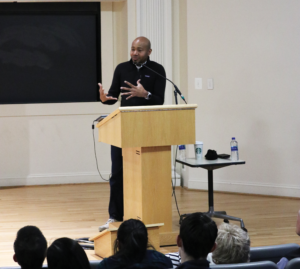Paul Miller, commonly known as DJ Spooky, spoke about the influence multimedia has in reshaping identity and racial prejudice in public discourse Feb. 12.
Miller, a composer, multimedia artist and writer, is the director and producer of “Rebirth of a Nation,” a 2007 remake of the 1915 D.W. Griffith silent drama “Birth of a Nation.”

Griffith’s “Birth of a Nation,” adapted from the novel and play “The Clansman” by Thomas Dixon Jr., tells a post-Civil War era story that heroicizes the Klu Klux Klan. The film sparked protests from the National Association for the Advancement of Colored People at the time of its release because of its racist depictions of black men as lazy, aggressive and lustful, according to The New Yorker.
Miller said that Griffith’s film shaped social perceptions at the time of its release, allowing for traditional and xenophobic attitudes on immigration and race to be absorbed by media and culture.
“In 1915, the world changed because we saw the rise of this notion that cinema and politics converged to create this kind of perfect storm of racial politics and the way politics would then influence the paradox of history, time, and above all, truth,” Miller said. “Birth of a Nation set the tone for 20th century media because it was the first film to establish itself as truth.”
Miller underscored the historical significance of “Birth of a Nation” as literature that gives a glimpse into racial tensions on phenomena beyond cultural perception, like politics.
In “Rebirth of a Nation,” Miller uses the approach of a DJ remix by reconstructing and paralleling a song to the film. The piece aims to expose the racist undertones of “Birth of a Nation” by applying the technology of turntable remix to a piece of historical literature. In screenings of the film, Miller manipulates video clips live on stage, often accompanied by an instrumental quartet, according to The Washington Post.
While using a new approach to addressing racial histories in the United States, Miller said that remaking historical pieces can be a tool for rescripting current history just as the original pieces did in their time.
“Amusingly enough, to me at least, half the battle right now is looking at these kinds of histories and articulating history through this kind of remix culture,” Miller said.
Held in McNeir Hall, the event was part of the Racial Justice: Art(s) and Activism lecture series, which highlights the intersection of art, activism and racial justice by giving a platform to art that produces new forms of racial freedom. The discussion was sponsored by the Georgetown University Departments of African American Studies and Performing Arts and the Racial Justice Institute.
One of the biggest recent changes in media consumption is the reduction of intermediaries between producers and consumers, according to Miller.
“We’re looking at now disintermediation as we move further into the 21st century,” Miller said. “The phone actually becomes the portal of experience for most people.”
Miller’s previous projects as an artist and turntablist have been featured in the Museum of Contemporary Art in Chicago and the Museum Ludwig in Cologne, Germany. “Rebirth of a Nation” was commissioned in 2004 by the Lincoln Center Festival and has been screened in multiple cities, including at the John F. Kennedy Center for the Performing Arts in Washington, D.C.
A D.C. native, Miller also spoke about how the District is complex in terms of racial tensions as both a governmental center and as a city that contains a large black population.
“The fun part about living in D.C. is there’s sort of a paradox between the global and the federal issues of government,” Miller said. “And above all the paradox of the fact that it was not only an African-American city but also related to the federal government’s occupying force.”




















